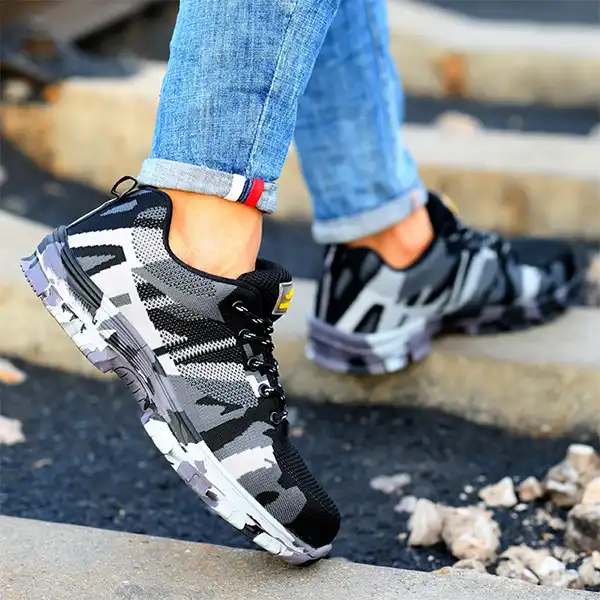
Battle-Tested at Love Park: How Breathable Camo Safety Shoes Saved My Philly Construction Summer
When our crew landed the contract to renovate Philadelphia’s iconic Love Park last summer, I had no idea it would completely change my perspective on construction footwear. After fifteen years of sweaty feet, constant discomfort, and end-of-day misery, I finally found something that worked. Here’s what happened when traditional safety boots met their match in the Philly summer heat.
The Philly Construction Challenge No One Talks About
If you’ve ever worked construction in Philadelphia during summer, you know exactly what I’m talking about. The humidity is brutal. The concrete radiates heat like a pizza oven. And most days, you’re basically working in a steam room while wearing what feels like concrete blocks on your feet.
Our Love Park renovation project kicked off in early June—right when Philly’s infamous humidity starts cranking up to unbearable levels. With a tight deadline and city officials regularly checking our progress, we couldn’t afford any slowdowns or comfort complaints.
The first week on site, temperatures hit 92°F with 80% humidity. My traditional work boots—the same heavy-duty style I’d worn for over a decade—turned into personal foot saunas. By lunch break, my socks were completely soaked, and by day’s end, I was dealing with painful blisters despite my veteran status.
Something had to change.
The Skeptic’s Introduction to Modern Safety Footwear
Joey, our newest crew member (and youngest by about 15 years), showed up the second week sporting these camouflage safety shoes that looked nothing like traditional construction footwear. The old-timers immediately started the usual ribbing:
“What are those, your gym shoes?” “Those won’t last a week on this concrete.” “First drop test and you’ll be crying for your mama.”
Joey just shrugged and said, “Let’s see who’s limping at quitting time.”
By mid-afternoon, I noticed Joey was still moving at the same pace while the rest of us had slowed down. No pit stops to air out his feet. No grimacing with each step. Just consistent productivity.
After three days of watching this, my curiosity finally overcame my stubbornness. I asked to check out his footwear during lunch break.
What I found shocked me. These weren’t flimsy fashion shoes with a token steel toe slapped on. They were legitimately engineered safety footwear with all the necessary protective elements, just approached from a completely different design philosophy.
The Love Park Testing Ground
If there’s any project that could put safety footwear through its paces, it was the Love Park renovation. Our daily work environment included:
• Demolition of old concrete structures • Precision cutting and fitting of granite blocks • Waterproofing installation for the fountain systems • Heavy machinery operation on uneven surfaces • Constant transitions between wet and dry areas • 10+ hour days in extreme temperature conditions
After seeing Joey’s productivity advantage, five of us decided to try these breathable camouflage safety shoes ourselves. The remainder of the crew stuck with their traditional boots, creating the perfect real-world comparison test.
What happened next completely changed my approach to work footwear.
The Real-World Performance Breakdown
Breathability: The Game-Changer
The most immediate difference was breathability. The mesh-knit upper design allowed continuous airflow that kept my feet dry even during peak afternoon heat. After years of considering foot sweat an unavoidable construction reality, suddenly it wasn’t an issue.
“It’s like someone installed AC in my shoes,” Mike from our concrete team put it perfectly after his first day.
The impact on comfort was dramatic, but the bigger revelation was how it affected stamina. Without the energy drain of overheated feet, our productivity remained more consistent throughout the day. The site super actually commented on the improved afternoon pace of those who had switched footwear.
Protection That Doesn’t Punish
My biggest concern was sacrificing protection for comfort. The Love Park site had plenty of hazards to test this—dropped tools, sharp granite edges, protruding rebar, and heavy machinery in tight quarters.
The first true test came when I accidentally dropped a concrete core drill that bounced off my toe. In traditional boots, I would have felt it but been protected. With these, I barely felt anything—the steel toe design absorbed the impact just as effectively, but with significantly less weight.
Throughout the three-month project, we collectively encountered:
• Multiple heavy tool drops (including a 15lb demolition hammer) • Stepping on exposed nails and screws during demo phases • Working around waterproofing chemicals and adhesives • Operating plate compactors and other vibrating equipment • Continuous contact with abrasive materials
In each scenario, the protective elements performed as needed without the traditional bulk and weight penalty.
All-Day Comfort Metrics
Perhaps the most telling metric was what happened after work. With my old boots, the first thing I’d do after getting home was kick them off, often nursing sore feet and anticipating the same discomfort the next day.
With these breathable safety shoes, I often forgot to change out of them after getting home—the ultimate testament to their comfort level.
The crew members who switched reported similar experiences:
• Significantly reduced foot fatigue at day’s end • Less lower back pain (a common issue with heavy footwear) • Faster recovery between shifts • Fewer instances of blisters and hot spots • Reduced leg muscle fatigue when working on scaffolding
Weather Adaptability in Philly’s Unpredictable Climate
Another surprising benefit emerged during Philadelphia’s notorious summer thunderstorms. The Love Park site would transform from bone-dry to partially flooded in minutes, with work continuing through all but the most severe downpours.
The waterproof layer proved remarkably effective without compromising breathability. My feet stayed dry walking through puddles that would have required a complete sock change with traditional partially-waterproof boots.
Even more impressive was the quick-drying capability. After getting thoroughly soaked during a particularly heavy downpour, the shoes had dried substantially within an hour, while traditional leather boots would remain damp into the next workday.
Durability: The Long-Term Test
The ultimate question for any construction footwear is durability. Our Love Park project ran for just over three months, providing an excellent test period.
Here’s how the breathable camouflage safety shoes held up compared to traditional work boots worn by other crew members:
| Wear Point | Traditional Work Boots | Breathable Camo Safety Shoes |
|---|---|---|
| Outsole tread | Significant flattening at heel and ball of foot | Minimal wear pattern with tread depth maintained |
| Upper material | Creasing and material fatigue at flex points | Maintained shape with minimal deformation |
| Interior cushioning | Noticeable compression by project end | Retained approximately 85% of original support |
| Protective elements | Unchanged but increasingly uncomfortable | Maintained protection without comfort degradation |
| Water resistance | Declining effectiveness requiring treatments | Consistent performance throughout project |
After the Love Park project concluded, I continued wearing the same pair for another four months on various job sites. They ultimately lasted about 30% longer than my typical work boots despite their lighter construction—an unexpected durability advantage.
The Style Factor: Surprisingly Important
I’ll admit it—I initially scoffed at the camouflage pattern as being unprofessional. I was wrong, and here’s why:
The distinct pattern actually served practical purposes on a high-visibility project like Love Park. When working in teams, being able to quickly identify crew members’ positions from a distance improved coordination. The unique appearance also created immediate visual separation from public visitors who occasionally wandered too close to work areas.
Additionally, the modern design eliminated the need to change footwear when meeting with city officials or project stakeholders who would visit the site. They looked appropriate in both work and semi-professional contexts.
“First time in 20 years I didn’t feel underdressed meeting the suits with my work gear on,” noted our foreman after a particularly important project review.
Common Questions About Modern Safety Footwear
After our Love Park experience, we’ve fielded numerous questions from other construction professionals curious about our footwear choice:
Are breathable safety shoes actually OSHA-compliant for construction?
Absolutely. These meet ASTM F2413-18 standards for protective footwear including impact, compression, and puncture resistance. Always check certification markings, but properly rated modern safety shoes satisfy all the same requirements as traditional boots.
How do they handle specialized construction environments?
Exceptionally well for most scenarios. For extreme conditions (like continuous exposure to caustic chemicals or prolonged standing in deep water), specialized boots may still be preferred. However, for standard construction activities including those at Love Park, they performed better than traditional alternatives in most respects.
Won’t the breathable materials let debris in?
The mesh design is engineered to prevent most debris infiltration. During our Love Park work, which included significant dust and small particles, this proved to be a non-issue. The tongue design and proper lacing create effective seals against typical construction debris.
Can they really handle the punishment of daily construction work?
Based on our extended testing through the Love Park project and beyond, yes. The advanced materials often demonstrate better abrasion resistance than traditional leather while maintaining flexibility. The key is looking for models specifically rated for construction environments, not fashion-focused knockoffs.
Do they provide enough ankle support?
This was my biggest initial concern. For most applications, the secure fit provided adequate stability. For specialized work requiring extra ankle support, high-top versions are available. At Love Park, even during work on uneven demolition surfaces, ankle issues never materialized.
The Value Proposition: Beyond Comfort
When evaluating the true value of these breathable camouflage safety shoes versus traditional construction boots, consider these factors from our Love Park experience:
• Productivity impact: Reduced fatigue translated to measurably higher afternoon output • Extended useful life: Despite lighter construction, they outlasted traditional options • Recovery benefits: Reduced physical toll meant better physical condition for the next day’s work • Multiple-use versatility: Appropriate for various environments without changing footwear • Health considerations: Less foot moisture led to fewer skin issues and improved foot health
When factoring these elements against the initial price (typically 15-20% higher than mid-range traditional work boots), the value equation strongly favors the modern approach.
The Philadelphia Construction Worker’s Verdict
After completing the Love Park renovation and continuing to use these shoes on subsequent projects, my perspective has completely changed. What initially seemed like a concession to modern styling over function proved to be a legitimate advancement in construction footwear.
The combination of proper protection, all-day comfort, and impressive durability makes these breathable camouflage safety shoes the new standard for my workwear. The entire crew that made the switch during the Love Park project has maintained their choice, with several influencing workers on other sites to make similar changes.
As Philadelphia construction veteran Mike Rodriguez perfectly summarized, “Thirty years I’ve been busting my feet on job sites thinking misery was just part of the gig. Turns out the problem wasn’t the work—it was the damn boots.”
Ready to Revolutionize Your Workday?
If you’re still suffering through shifts in outdated, uncomfortable safety boots, it’s time to experience the difference that proper breathable safety footwear can make. Your feet support you through grueling workdays—isn’t it time your footwear did the same? 👷♂️👷♀️
Don’t let another workday be ruined by painful, sweat-soaked feet. Upgrade to breathable camouflage safety shoes and experience the revolution in work comfort that helped us conquer the Love Park renovation. Click below to find your perfect pair!
